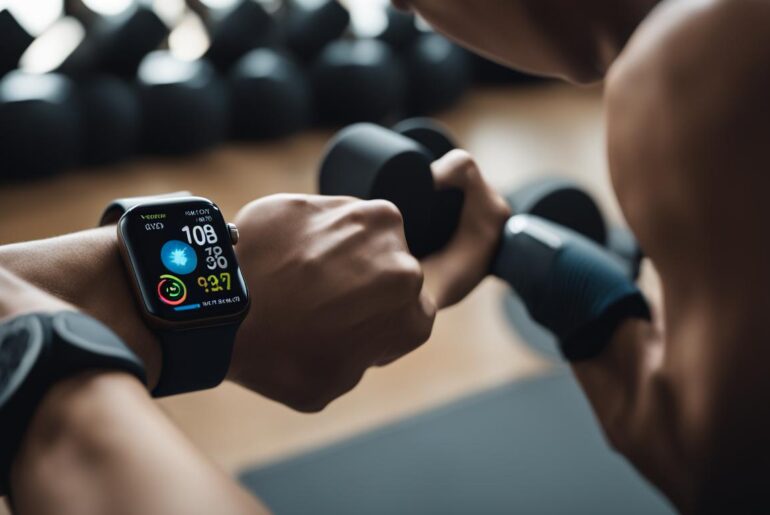The Apple Watch has become increasingly popular for fitness tracking, providing users with valuable data on their workouts. However, when it comes to traditional strength training, the Apple Watch may not be as intuitive. Tracking reps, sets, and weight lifted can be a challenge, but there are ways to utilize your Apple Watch for strength training routines.
The Apple Watch does offer a “Strength Training” workout option, which tracks calories, time, and heart rate. While this provides some basic information, it doesn’t capture the full picture of your strength training progress. To track your reps, sets, and weight lifted, you can explore other options such as using Voice Memos or third-party apps.
By keeping track of your workouts, you can easily monitor your progress and plan your time in the gym more effectively. Let’s explore some methods that will help you make the most out of your Apple Watch for traditional strength training.
Key Takeaways:
- Traditional strength training on Apple Watch may require additional methods to track reps, sets, and weight lifted.
- Utilizing Voice Memos or third-party apps can enhance your strength training tracking experience.
- Tracking your workouts can help you monitor your progress and plan your time in the gym.
- The Apple Watch’s built-in “Strength Training” workout option only tracks calories, time, and heart rate.
- Exploring alternative methods such as Voice Memos or third-party apps can provide more detailed tracking features.
Tracking Workouts with the Apple Watch
The Apple Watch provides a built-in Workout app that offers a “Strength Training” workout option. However, this option falls short in tracking the specifics of your strength training routine. It primarily focuses on calories, time, and heart rate, omitting important details like reps, sets, and weight lifted.
To overcome this limitation, there are alternative methods you can explore. One option is to use Voice Memos to record your sets and reps during your workout. Although this method requires some extra effort and post-workout logging, it can be a convenient way to keep track of your performance.
Another option is to utilize third-party apps specifically designed for strength training. Apps like Fitbod, Gymaholic, and Strong offer more comprehensive tracking features, allowing you to log reps, sets, weight lifted, and even calories burned. These apps cater to different lifters, ranging from novice to advanced, providing personalized tracking capabilities for your strength training sessions.
Key Takeaways:
- The Apple Watch’s built-in “Strength Training” option focuses on calories, time, and heart rate.
- Using Voice Memos can be a practical way to track your sets and reps during a strength training workout.
- Third-party apps like Fitbod, Gymaholic, and Strong offer more detailed tracking features for strength training.
- These apps cater to different levels of lifting experience, providing personalized tracking capabilities.
Tracking Workouts with the Apple Watch
When it comes to traditional strength training, the Apple Watch’s built-in Workout app offers a “Strength Training” option. However, this feature only tracks calories, time, and heart rate, leaving out important metrics like reps, sets, and weight lifted. To track your workouts more accurately, there are a couple of options you can consider.
- Using Voice Memos: One method is to utilize the Voice Memos app on your Apple Watch. During your workout, you can simply speak your sets and reps into the app, and then log them after you finish your session. While this method requires manual entry, it provides a seamless way to collect data without the need for pen and paper.
- Third-Party Apps: Another option is to explore third-party apps specifically designed for strength training. Apps like Fitbod, Gymaholic, and Strong offer detailed tracking features that can monitor reps, sets, weight lifted, calories burned, and other relevant metrics. These apps cater to individuals of all fitness levels, whether you’re a novice, intermediate, or advanced lifter.
By leveraging these methods, you can enhance your tracking capabilities and personalize your strength training experience with the Apple Watch.
Benefits of Logging Your Workouts

Logging your workouts can bring numerous benefits to your fitness journey. Not only does it allow you to easily track your progress, but it also provides valuable insights into your weightlifting endeavors. By keeping a detailed workout log, you can monitor how much weight you have lifted and observe the growth of your muscles, enabling you to stay motivated and focused on your weightlifting progress.
Furthermore, a workout log plays a crucial role in planning your time at the gym. Similar to having a grocery list before going to the store, a well-documented workout log helps you structure your workouts efficiently. With a clear plan in place, you can optimize your gym sessions and make the most out of your training time.
Another significant benefit of logging your workouts is the motivational aspect. On days when you may feel discouraged or lacking motivation, referring to your workout log can reignite your determination. It serves as a visual representation of how far you have come and the progress you have made. Reflecting on your past achievements can provide the much-needed motivation to push through challenging workouts and overcome plateaus.
In summary, keeping a workout log offers a range of benefits, including tracking your weightlifting progress, facilitating workout planning, and boosting motivation. By documenting your workouts, you can witness tangible improvements, optimize your training, and stay committed to your fitness goals.
The Key Benefits of Logging Workouts:
- Easily track your weightlifting progress
- Efficiently plan and structure your gym sessions
- Maintain motivation and overcome workout plateaus
Apple Watch’s “Strength Training” Workout Option
The Apple Watch’s built-in Workout app offers a “Strength Training” workout option, allowing you to incorporate your strength training sessions into your fitness tracking routine. However, it’s important to note that this feature has its limitations.
By default, the “Strength Training” workout option on the Apple Watch tracks metrics such as calories burned, time spent, and heart rate during your workout. While these metrics provide valuable information, it does not track specific details like reps, sets, or weight lifted.
However, if you are using watchOS 7 or newer, you have the option to choose between two different modules for your strength training workouts: Functional Strength Training and Traditional Strength Training.
The Functional Strength Training module is ideal for bodyweight exercises or workouts that involve small accessories. On the other hand, the Traditional Strength Training module is designed for common lifting exercises such as bench press or deadlift.
It’s worth noting that if you are using an Apple Watch with watchOS 6 or older, the “Strength Training” workout option does not have pre-set modules for traditional or functional training. In this case, you will need to manually add a workout and track your exercises and metrics manually.
If you prefer a more comprehensive and detailed tracking experience for your strength training workouts, there are third-party apps available that offer advanced tracking features specifically designed for strength training. These apps can provide a more holistic view of your workout, including reps, sets, weight lifted, and other relevant metrics.
While the Apple Watch’s built-in workout option for strength training may have its limitations, it still provides a convenient way to track your overall fitness and stay motivated on your strength training journey.
Using Voice Memos for Tracking Workouts
![]()
While the Apple Watch’s built-in Workout app may not track reps, sets, or weight lifted, there is a simple and convenient method to record your performance: Voice Memos. With Voice Memos, you can seamlessly capture your fitness data and easily log your sets and statistics after your workout.
Here’s how you can use Voice Memos to track your workouts:
- Open the Voice Memos app on your iPhone or Apple Watch.
- Start a new recording and speak your workout totals, such as the number of reps, sets, and weight lifted.
- End the recording once you have finished.
- After your workout, you can play back the recordings and log your sets in your preferred tracking app or method.
This method may require a bit more dedication to tracking compared to using built-in features, but it offers seamless data collection without the need for pen and paper. Plus, the recordings can be streamed to your iPhone, providing a secure way to keep track of your performance.
Using Voice Memos not only allows you to easily record your workouts, but it also provides you with an opportunity to reflect on your performance and progress over time. You can listen to your previous recordings and see how far you’ve come on your fitness journey.
Benefits of Using Voice Memos for Tracking Workouts:
1. Convenience: Voice Memos make it easy to capture your workout data without interrupting your training sessions. Simply speak your totals and continue with your workout.
2. Seamless Data Collection: You can effortlessly record your sets and statistics, ensuring accurate tracking of your workouts.
3. Flexibility: You can use Voice Memos with any workout routine or exercise, making it a versatile tracking method for all types of strength training.
4. Reflective Practice: By listening to your previous recordings, you can analyze your performance, identify areas for improvement, and track your progress over time.
“Using Voice Memos for tracking workouts provides a seamless and flexible way to collect data, empowering you to make informed decisions and progress on your fitness journey.”
Comparison of Voice Memos and Built-in Tracking Methods:
| Method | Pros | Cons |
|---|---|---|
| Voice Memos | – Easy and convenient to use – No additional equipment required – Can be streamed to iPhone for secure recordkeeping |
– Manual entry of data – Requires playback and transcription of recordings – No immediate reference during workouts |
| Built-in Workout App | – Automatic data tracking – Real-time feedback during workouts |
– Limited tracking features for strength training – Does not track reps, sets, or weight lifted |
Both methods have their advantages and limitations, so it’s important to choose the one that best suits your tracking preferences and training goals.
In conclusion, while the Apple Watch’s built-in Workout app may not offer seamless tracking of traditional strength training exercises, Voice Memos provide a practical and convenient solution. By utilizing Voice Memos, you can seamlessly record your sets and statistics, ensuring accurate data collection for your strength training workouts.
Third-Party Apps for Tracking Workouts
If you prefer not to use Voice Memos, there are several third-party apps available for strength training tracking on the Apple Watch. These apps offer more detailed tracking features to help you monitor your progress and maximize your workout efficiency. Here are three popular options:
Fitbod: Fitbod is a great choice for novice lifters. It provides personalized workouts and integrates seamlessly with the Health app. With Fitbod, you can easily track your strength training sessions and view comprehensive analytics to measure your improvement over time.
Gymaholic: Gymaholic is designed for intermediate lifters who want to take their training to the next level. This app offers pre-programmed workouts and advanced tracking features. Gymaholic helps you stay on top of your fitness goals with detailed data on reps, sets, weight lifted, and more.
Strong: Strong is recommended for advanced lifters who prefer a more flexible approach to their workouts. With Strong, you have the freedom to create and curate your own training routines. You can track not only reps, sets, and weight, but also body fat percentage, making it a comprehensive fitness tracking tool.
These third-party apps can be easily downloaded from the App Store and synced with your Apple Watch. By using Fitbod, Gymaholic, or Strong, you can take advantage of their detailed tracking features and make the most out of your strength training sessions.
Comparison of Third-Party Apps for Tracking Workouts
| App | Target Audience | Features |
|---|---|---|
| Fitbod | Novice lifters | Integration with Health app, personalized workouts |
| Gymaholic | Intermediate lifters | Pre-programmed workouts, advanced tracking features |
| Strong | Advanced lifters | Manual workout creation, detailed tracking (reps, sets, weight, body fat percentage) |
Choosing the right app depends on your fitness level and personal preferences. Whether you’re just starting out or a seasoned lifter, these third-party apps can enhance your strength training experience and provide you with detailed insights to optimize your workouts.
How Can I Use Apple Watch to Improve My Traditional Strength Training Routine?
Start by tracking your progress and setting goals using the Workout app on your Apple Watch. Utilize the heart rate sensor to monitor intensity and rest periods, optimizing strength workouts with Apple. Take advantage of the reminders and notifications to stay consistent and motivated, pushing yourself to maximize results.
The Apple Watch’s Potential for Strength Training

The Apple Watch is not only efficient for running, yoga, and calorie-burning workouts, but it can also be a valuable tool for strength training. With the right apps or methods, you can unlock the tracking potential of your Apple Watch and have a digital gym partner.
Whether you choose the Apple Watch Ultra with its advanced tracking features or any of the latest Apple Watch releases, you can utilize the tracking potential to enhance your strength training workouts.
Track reps, sets, and weight lifted to monitor your progress and push yourself further. Time your rest periods to optimize recovery and performance. The Apple Watch has the capability to provide personalized tracking features that cater to your specific strength training needs.
Not only does the Apple Watch offer a sleek and stylish design, but it also integrates seamlessly into your strength training routine. Say goodbye to manual logging and hello to hassle-free data collection with the power of your Apple Watch.
Unlock the full potential of your strength training with the Apple Watch as your reliable fitness companion. Say goodbye to pen and paper and embrace the convenience and accuracy of digital tracking.
Apple Watch Ultra: The Ultimate Gym Partner
If you’re an athlete or a fitness enthusiast looking to take your strength training to the next level, the Apple Watch Ultra is the perfect choice for you. Packed with advanced tracking features and cutting-edge technology, the Apple Watch Ultra is designed to elevate your gym experience.
Equipped with enhanced sensors and optimized performance, the Apple Watch Ultra can accurately measure your heart rate, calories burned, and much more. Its durable construction and swim-proof design make it suitable for all types of workouts, including intense strength training sessions.
Take advantage of the Apple Watch Ultra’s comprehensive tracking capabilities to monitor your progress, set new goals, and stay motivated. From recording your sets and reps to analyzing your workout data, this powerful device can provide valuable insights to help you optimize your training routine.
The Latest Apple Watch Releases: Unleash Your Potential
If you don’t have the Apple Watch Ultra, don’t worry! You can still leverage the tracking potential of the latest Apple Watch releases for your strength training workouts.
Whether you own the Apple Watch Series 6, SE, or any previous model, the Apple Watch offers a range of features and functionalities to enhance your fitness journey. Seamlessly track your workouts, monitor your heart rate, and stay connected while focusing on your strength training goals.
Choose from a variety of customizable workout apps and third-party fitness applications to tailor your strength training experience. These apps can provide detailed tracking, guidance, and workout recommendations to help you make the most of every training session.
Conclusion
The Apple Watch may not have built-in features specifically tailored for traditional strength training, but with the right methods and apps, you can utilize its tracking capabilities to enhance your gym workouts. By keeping a workout log, using Voice Memos, or utilizing third-party apps, you can effectively track your progress, plan your workouts, and stay motivated.
The Apple Watch has the potential to be a valuable tool in your strength training journey. Its personalized tracking features can provide you with important insights into your workout performance, allowing you to make informed decisions about your training and make improvements where needed. Whether you’re looking to track your reps, sets, or weight lifted, or simply time your rest periods, the Apple Watch can elevate your gym workouts to a new level.
Remember, consistency is key when it comes to strength training. By incorporating the Apple Watch into your routine, you can ensure that you are accurately tracking your progress and staying on top of your fitness goals. So take advantage of the Apple Watch’s capabilities, explore the various tracking methods and apps available, and let it become your ultimate training companion.
Source Links
- https://www.gearpatrol.com/fitness/a40679324/apple-watch-strength-training/
- https://support.apple.com/en-lamr/105089
- https://www.techradar.com/health-fitness/smartwatches/this-lesser-known-apple-watch-ultra-skill-can-help-improve-your-gym-workout




